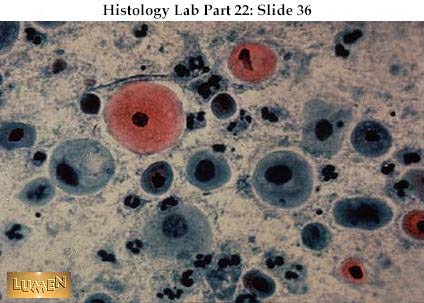Mammalian Pap smear references
(I am working my way through this list this summer, and have not finished getting/reading each article yet. After I have finished, I will summarize the best articles.)
Barrett RP. Exfoliative vaginal cytology of the dog using Wright's stain. Vet Med Small Anim Clin. 1976 Sep;71(9):1236-8.
Bell ET, Bailey JB, Christie DW. Studies on vaginal cytology during the canine oestrous cycle. Res Vet Sci. 1973 Mar;14(2):173-9.
Bell ET, Bailey JB, Christie DW. Studies on vaginal cytology during the canine oestrous cycle. J Endocrinol. 1970 Sep;48(1):iv-v.
Bell ET, Christie DW. Duration of proestrus, oestrus and vulval bleeding in the beagle bitch. Br Vet J. 1971 Aug;127(8):xxv-xxvii
Bell ET, Christie DW. Erythrocytes and leucocytes in the vaginal smear of the beagle bitch. Vet Rec. 1971 May 22;88(21):546-9.
Bell ET, Christie DW. The evaluation of cellular indices in canine vaginal cytology. Br Vet J. 1971 Dec;127(12):Suppl:63-5.
Bigg MA. Adaptations in the breeding of the harbour seal, Phoca vitulina. J Reprod Fertil Suppl. 1973 Dec;19:131-42.
Boue F, Delhomme A, Chaffaux S. Reproductive management of silver foxes (Vulpes vulpes) in captivity. Theriogenology. 2000 Jun;53(9):1717-28.
Christie DW, Bailey JB, Bell ET. Classification of cell types in vaginal smears during the canine oestrous cycle. Br Vet J. 1972 Jun;128(6):301-10.
Christie DW, Bailey JB, Bell ET. The collection of vaginal smears from the Beagle bitch. Vet Rec. 1970 Aug 29;87(9):265.
Deleon I, Alvarez-Buylla R, De Alvarez-Buylla ER. Hormonal vaginal cytology in Canis familiaris. Acta Physiol Lat Am. 1972;22(4):227-32.
Doboszynska T. A method for collecting and staining vaginal smears from the beaver. cta Theriol (Warsz). 1976 May;21(12-23):299-306.
Dore MA. The role of the vaginal smear in the detection of metoestrus and anoestrus in the bitch. J Small Anim Pract. 1978 Oct;19(10):561-72.
Drill VA. Evaluation of the carcinogenic effects of estrogens, progestins and oral contraceptives on cervix, uterus and ovary of animals and man. Arch Toxicol Suppl. 1979;(2):59-84.
Durrant B, Czekala N, Olson M, Anderson A, Amodeo D, Campos-Morales R, Gual-Sill F, Ramos-Garza J. Papanicolaou staining of exfoliated vaginal epithelial cells facilitates the prediction of ovulation in the giant panda. Theriogenology. 2002 Apr 15;57(7):1855-64.
Evans JM, Savage TJ. The collection of vaginal smears from bitches. Vet Rec. 1970 Nov 7;87(19):598-9.
Fowler EH, Feldman MK, Loeb WF. Comparison of histologic features of ovarian and uterine tissues with vaginal smears of the bitch. Am J Vet Res. 1971 Feb;32(2):327-34.
Frankland AL. The collection of vaginal smears from the bitch. Vet Rec. 1971 Jul 24;89(4):127.
Herron MA. Feline reproduction. Vet Clin North Am. 1977 Nov;7(4):715-22.
Holst PA, Phemister RD. Onset of diestrus in the Beagle bitch: definition and significance. Am J Vet Res. 1974 Mar;35(3):401-6.
Laiblin C, Rohloff D. [Artificial insemination of the dog with special reference to estrus diagnosis] Tierarztl Prax. 1981;9(2):237-44. German.
Mellors RC, Papanicolaou GN, Glassman A. A microfluorometric method under development for the scanning and the detection of cancer cells in vaginal smears. Am J Pathol. 1951 Jul-Aug;27(4):734-5.
Northway RB. Use of phase microscopy with vaginal smears to determine ovulation in the bitch. Vet Med Small Anim Clin. 1972 May;67(5):538 passim.
Papanicolaou GN. A survey of the actualities and potentialities of exfoliative cytology in cancer diagnosis. Ann Intern Med. 1949 Oct;31(4):661-74.
Papanicolaou GN. Historical development of cytology as a tool in clinical medicine and in cancer research. Acta Unio Int Contra Cancrum. 1958;14(4):249-54.
Papanicolaou GN. The evolutionary dynamics and trends of exfoliative cytology. Tex Rep Biol Med. 1955;13(4):901-19.
Phemister RD, Holst PA, Spano JS, Hopwood ML. Time of ovulation in the beagle bitch. Biol Reprod. 1973 Feb;8(1):74-82.
Roszel JF. Normal canine vaginal cytology. Vet Clin North Am. 1977 Nov;7(4):667-81.
Schutte AP. Canine vaginal cytology. I. Technique and cytological morphology. J Small Anim Pract. 1967 Jun;8(6):301-6.
Schutte AP. Canine vaginal cytology. II. Cyclic changes. J Small Anim Pract. 1967 Jun;8(6):307-11.
Schutte AP. Canine vaginal cytology. III. Compilation and evaluation of cellular indices. J Small Anim Pract. 1967 Jun;8(6):313-7.
Shille VM, Lundstrom KE, Stabenfeldt GH. Follicular function in the domestic cat as determined by estradiol-17 beta concentrations in plasma: relation to estrous behavior and cornification of exfoliated vaginal epithelium. Biol Reprod. 1979 Nov;21(4):953-63.
Simmons J. The vaginal smear and its practical application. Vet Med Small Anim Clin. 1970 Apr;65(4):369-73.
Stenson GB. Oestrus and the vaginal smear cycle of the river otter, Lutra canadensis. J Reprod Fertil. 1988 Jul;83(2):605-10.
Strasser H, Brunk R, Baeder C. [Sexual cycle of the cat] Berl Munch Tierarztl Wochenschr. 1971 Jul 1;84(13):253-4.
Valtonen MH, Rajakoski EJ, Makela JI. Reproductive features in the female raccoon dog (Nyctereutes procyonoides). J Reprod Fertil. 1977 Nov;51(2):517-8.
Witiak E. The use of vaginal smears to determine ovulation in the bitch. Vet Med Small Anim Clin. 1967 Sep;62(9):869-78.
Wright PJ, Parry BW. Cytology of the canine reproductive system. Vet Clin North Am Small Anim Pract. 1989 Sep;19(5):851-74.
Wrobel KH, El Etreby MF, Gunzel P. [Histochemical and histological investigations on the vagina of the beagle she-dog during various functional conditions (author's transl)] Acta Histochem. 1975;52(2):257-70.
Read more!



.jpg)
